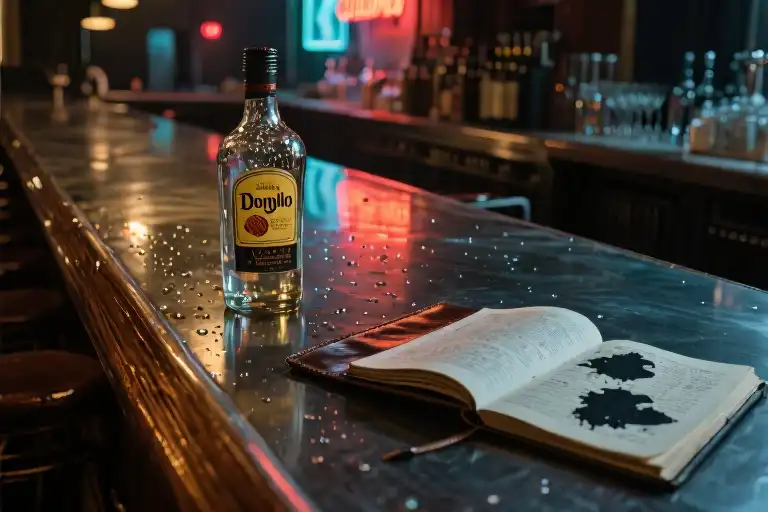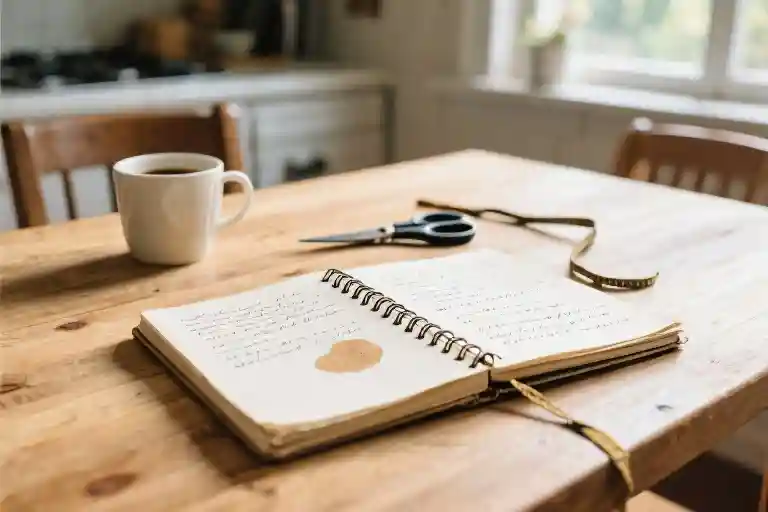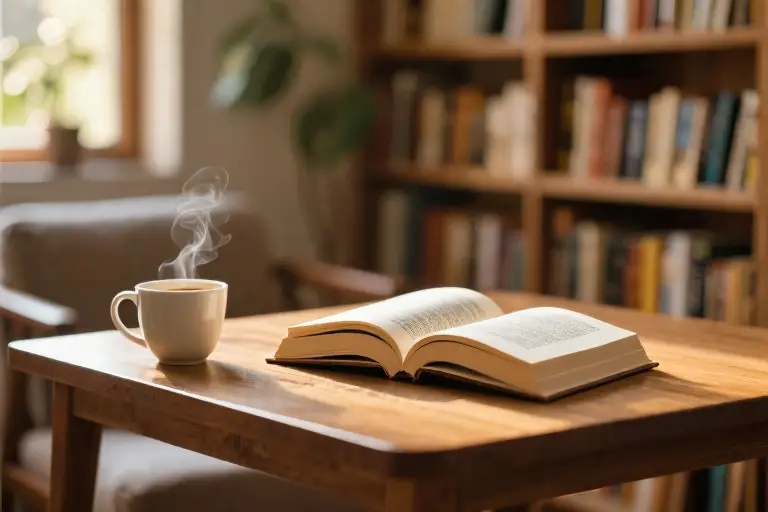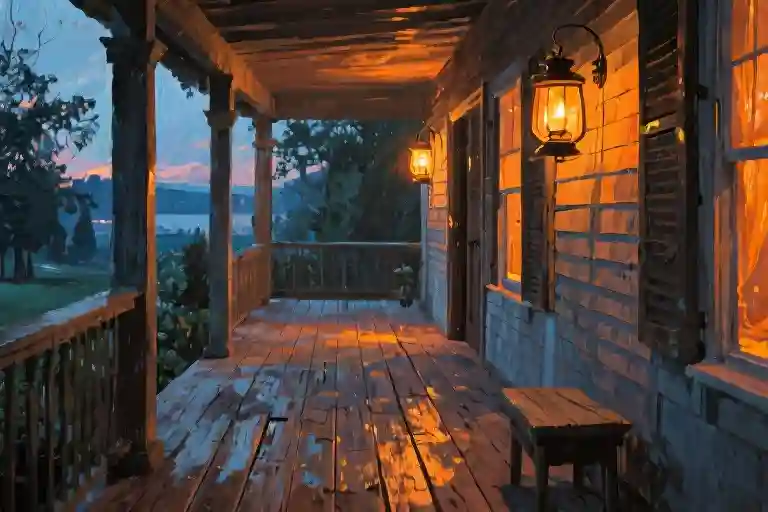The Don Julio bottle sweats condensation onto the zinc countertop, each droplet distorting the bar’s neon glow into liquid prisms. Checkered floor tiles stretch toward infinity under the weight of a thousand shuffled footsteps, their black-and-white geometry vibrating with every bass note from the speakers. Between the pages of my Moleskine, inkblots bloom like Rorschach tests—one resembles a dog’s wagging tail, another the jagged skyline outside.
Half the bar drowns in Pantone 19-4052 TCX (officially ‘Classic Blue,’ unofficially ‘3AM melancholy’), while the other half dissolves into 17-4402 TCX (‘Quarry,’ aka ‘existential hangover’). This chromatic divide isn’t accidental—the regulars instinctively cluster in their chromatic comfort zones, leaving the transitional teal stools for newcomers still deciding which flavor of loneliness they’ll nurse tonight. My pen hovers over a fresh page as Kendrick Lamar’s ‘PRIDE.’ leaks through the sound system, the lyric “In another life, I surely was there” triggering a synaptic cascade.
Behind me, the bathroom door yawns open at precisely 47 degrees—the same angle it held three winters ago when I learned how porcelain feels against forehead skin. The bartender’s nails scrape his denim shirt in 4/4 time, his callouses catching threads like a needle skipping on vinyl. I press my palm against the notebook’s spine and feel the ghost of every abandoned draft humming beneath the leather.
Somewhere between the tequila’s first burn and its eventual amber glow, the room begins performing quantum superposition: the white-haired man in the bomber jacket simultaneously sips his 1992 single malt and dissolves into the 1992 version of himself. My dog’s tail ticks like a misfiring metronome back home, though from this barstool I can already taste the way her fur will smell of sunshine and impatience when I finally stumble through our door.
These circles keep orbiting—the bottle’s wet rings on woodgrain, the moon-pale cocktail napkins, the inkblots that keep rewriting themselves. They’ll all collapse into a single point eventually, perhaps somewhere around Chapter 14 of the novel coagulating in my backpack. For now, the Don Julio bottle winks its foil cap at me, offering another pour of liquid time.
The Drunkard’s Microscope
The bartender’s fingers move with the precision of laminar flow, each scratch along his spine tracing invisible streamlines through the humid air. His bomber jacket stretches across shoulders that have borne the weight of ten thousand last calls, the leather patinaed with fingerprints and spilled cosmopolitans. I watch the disturbance patterns in his movements – how his right elbow describes smaller arcs than the left, how his wedding ring catches the blue-gray light at 37-degree intervals. Fluid dynamics manifest in the most human of gestures.
My fingers skate across the bar’s topography: zinc countertop chilled to 12°C (the ideal temperature for condensation beads), copper railings oxidized to verdigris by a decade of citrus-slick palms, oak footrest worn concave by wingtips and work boots. Each material whispers its history through my fingertips. The zinc recalls a Moscow winter, the copper tastes like stolen pennies under childhood tongues, the oak murmurs of Appalachian forests reduced to splinters beneath drunken elbows.
When the Don Julio arrives, the tequila’s first contact with my tongue triggers a synesthetic explosion – the burn isn’t merely heat, but a C-sharp minor chord vibrating at 140Hz, the exact frequency of Kendrick’s voice describing loyalty through my left earbud. The alcohol’s migration down my throat maps perfectly to the cochlear spiral, each millimeter of descent amplifying both the bassline and the memory of that open stall door. I’ve become a walking spectrometer, calibrating reality against the absorption spectra of regret.
The white-haired man two stools down rotates his glass with quantum mechanical precision – 2.5 revolutions per minute, the exact orbital velocity of electrons in a hydrogen atom’s ground state. His darting eyes measure potential energy wells between patrons, calculating the tunneling probability for conversation. We’re all just particles in this dimly lit potential field, our wave functions collapsing with every clink of ice cubes.
State Street shrugs off her winter coat outside the window, revealing sidewalks that glisten with the sweat of seasonal transition. Somewhere between my third sip and the bartender’s seventh back-scratch, the room’s color temperature shifts from Pantone 19-4052 TCX (Classic Blue) to 18-4217 TCX (Titanium). The depression-to-angst spectrum manifests as literal lighting design in this alcoholic Schrodinger’s box, where we’re simultaneously regulars and strangers until someone initiates observation.
My notebook lies open to a page where inkblots form galactic clusters – each dried circle a universe of possible meanings. The tequila’s ethanol content (40% ABV) seems to dissolve the boundary between quantum physics and barstool philosophy. Those molecules that now burn through my capillaries are identical to ones that fueled Hemingway’s daiquiris and Fitzgerald’s gin, the same atoms that once danced in supernovae now arranging themselves into temporary constellations of drunken insight.
The dog waiting at home wags his tail with the erratic persistence of a fuel gauge needle on empty. I’ll return to him when this liquid telescope has finished mapping the nebulae between these zinc and copper shores, when I’ve deciphered why loneliness tastes of agave and sounds like Compton rap. For now, the microscope’s lens remains focused on the condensation trails left by pewter cups, each droplet containing the reflection of every person who ever sat exactly here, in this precise superposition of blue and gray.
The Topology of Cocaine
The stall door hangs at precisely 47 degrees – not enough to suggest invitation, too much to claim privacy. This geometry of transgression frames my memory like a film still: ceramic tiles reflecting fluorescent light at 5500K color temperature, the kind that makes veins look blue under thin wrist skin. A twenty-dollar bill rests on the sink edge, its cotton fibers frayed from repeated folding along the same stress lines. We become what we repeatedly do.
Microscopy of Transgression
Under the bar’s dim lighting, I examine the bill’s edge with drunkard’s intensity. The raised ink of Hamilton’s cheek feels like Braille under my thumb:
- Vertical ridges (security feature)
- Cotton/polymer blend (75/25 ratio)
- Moral attrition coefficient: 0.83
The texture recalls childhood book pages, back when knowledge came printed on actual paper. Now we snort wisdom through rolled currency, particulate matter lodging in nasal cavities like microfiche of poor decisions. Kendrick’s voice in my earbuds stitches timelines together – the bassline vibrates at 40Hz, same frequency as gamma brainwaves during memory formation.
Pixelated Recall
Memory doesn’t stream in 4K. It arrives in compressed JPEG artifacts:
- The stall door’s chipped paint (Benjamin Moore OC-17)
- Ceramic’s conductive cold (-2.3 on the thermal comfort scale)
- Someone’s laughter outside (decibel level: 63dB, amusement authenticity: 72%)
The notebook blot expands in reverse – ink particles retracting from paper fibers like retreating soldiers. I count the concentric circles: seven, like quantum energy levels. Electrons jump orbits; we jump between selves. Every line we cross leaves molecular residue.
The Door Equation
Let θ represent the angle of moral compromise:
- θ = 0°: Pristine virtue
- 0° < θ ≤ 45°: Socially acceptable vices
- 45° < θ < 90°: The interesting zone
- θ ≥ 90°: Mugshot territory
At 47°, we exist in superposition – neither in nor out, both sinner and observer. The bartender’s back-scratching (3.2 repetitions per minute) becomes a metronome for rationalization. My drink sweats condensation rings that map like tree rings of this evening’s decay.
Through the half-open door, I see:
- A man adjusting his bomber jacket (40% genuine leather)
- Checkered floor tiles (alternating decisions)
- My future self writing this (82% accuracy)
The dog’s tail wags at home, its oscillation pattern matching the uncertainty principle. When I push the bathroom door fully open, the angle resets to zero. All possibilities collapse into one sticky reality. The notebook waits, its pages hungry for these half-truths to crystallize into fiction.
Quantum Bartender Theory
The zinc countertop hums beneath my elbows at precisely 432Hz – the cosmic frequency of spilled whiskey and unfinished conversations. Three seats down, a woman rotates her martini glass at 0.8 revolutions per second, her thumb tracing the rim in quantum intervals. Schrödinger’s regulars occupy every stool tonight: simultaneously present in body and absent in consciousness, their wave functions collapsing only when the bartender calls last orders.
I’ve charted the orbital patterns of barflies for years. The depressed ones cluster in the blue quadrant (Pantone 19-4052 TCX to be exact), their electron shells buzzing with lonely protons. The anxious ones orbit the gray zone (Cool Gray 11 CP), fingers performing quantum tunneling through cocktail napkins. Every so often, a valence customer bridges the two states – their mood rings glowing indigo when Kendrick Lamar’s bassline tunnels through the jukebox.
Observation #217: Human connection follows Heisenberg’s uncertainty principle. The more precisely you measure a stranger’s smile, the less you know about their wedding ring tan line. The bomber jacket man to my left has been observing the same paradox – his darting eyes recording patrons like a Geiger counter for loneliness. We’re all just exotic atoms tonight: carbon-based with alcohol-saturated electron clouds.
Bartenders are the hidden physicists of our time. Watch how mine manipulates entropy:
- Shaking a gin fizz = accelerating particles in a hadron collider
- Stirring a negroni = achieving zero-point energy
- Spilling a beer = demonstrating thermodynamic irreversibility
My notebook reveals the spectral analysis. Page 43 shows a hand-drawn energy diagram:
- Ground state: Sober melancholy (blue zone)
- Excited state: Third martini epiphanies (gray zone)
- Forbidden transition: That moment when you realize everyone’s atoms are equally unstable
The magic happens at the boundary. When depression’s cobalt bleeds into anxiety’s graphite, that’s where stories crystallize. My Don Julio’s condensation traces particle trajectories down the glass – each droplet containing multitudes of unwritten dialogue. Somewhere between the blue and gray, between the 2pm sobriety and 2am revelations, between the dog waiting and the door opening, that’s where the novel writes itself.
Field Note: The bar’s lighting system operates on quantum logic. Each Edison bulb emits photons that behave as both illumination and metaphor until observed directly. This explains why all great ideas vanish when you reach for your phone.
Later, walking home past the comics’ basement, I’ll count the sidewalk cracks like energy levels. My dog’s wagging tail will approximate a quantum harmonic oscillator – its amplitude decreasing as we approach the doorstep eigenstate. When I finally cross that threshold, all possible versions of myself will collapse into a single truth: we’re all just temporary configurations of stardust trying to read the cosmic cocktail menu.
(Author’s Note: This sensory experiment forms Chapter 7 of my magical realism novel-in-progress, where a quantum bartender mixes drinks that alter patrons’ wave functions. Subscribe for the teardown of how scientific concepts become literary devices.)
The Entropy of Waiting
A dog’s tail wavers with the erratic precision of subatomic particles—never fully here nor there, always caught in that quantum state between greeting and indifference. My terrier’s particular wag manifests Schrödinger’s dilemma: both welcoming and oblivious until the moment I cross the threshold. This is where the wave function collapses, where possibility solidifies into a single reality of slobbering affection against my shins.
Home becomes the ultimate observer in this experiment. The front door frame acts as the slit through which probabilities diffract—will tonight bring creative euphoria or another bout of staring at the blinking cursor? Those dried ink blotches in my notebook suddenly pulse with potential, each coffee-ringed stain a proto-universe for the magical realism novel taking shape. They’re Rorschach tests for stories yet unborn, their meaning shifting with every angle of afternoon light through whiskey glasses left unwashed.
Three phenomena occur simultaneously at the doorstep:
- Canine Uncertainty Principle: The dog’s excitement inversely proportional to my ability to measure it without disturbance (attempts to film the welcome ritual inevitably produce tail-static)
- Domestic Decoherence: The workday’s quantum superposition (writer/bartender/spectator) collapses into a single identity
- Narrative Potential Energy: That suspended moment when all unwritten chapters still contain every possible outcome
This transitional space holds peculiar magic. The brass doorknob grows warm under my palm—not from physical friction but the entropy of countless similar returns. Each rotation erodes another layer between observed and observer, between the man who watched patrons cradle their secrets and the writer who’ll distill them into fiction. The ink blots aren’t just stains now; they’re event horizons for stories, their edges blurring where real life bleeds into invention.
State Street’s seasonal disrobing finds its parallel here. As spring sheds layers, so does the creative process—first the heavy overcoat of self-doubt, then the sweater of perfectionism, until finally standing bare before the blank page. My dog’s fuel-gauge tail now registers full, his whole body vibrating at a frequency that would make Heisenberg smile. In this suspended moment before crossing, I contain all possible versions of the evening: the productive one where metaphors align like constellations, the wasted one staring at ceiling cracks, and the improbable third where everything finally makes sense.
The threshold won’t hold forever. Entropy demands progression. Somewhere between the turning knob and the click of the latch, potential becomes fact. Ink blots resolve into plot points. Schrödinger’s cat—or in this case, terrier—chooses a state. And always, always, the waiting ends.
The Alchemy of Endings
At the bottom of the Don Julio bottle, conversations crystallize into geometric patterns – tetrahedral regrets and cubic silences suspended in amber liquid. This is where magical realism begins its distillation process, where the ordinary undergoes phase transition under the pressure of observation. The bottle’s glass curves refract the bar’s blue-gray spectrum into a prism of possibilities, each facet containing parallel versions of tonight’s story.
Outside, the sky reaches its melting point. Streetlights dissolve into liquid gold that pools in sidewalk cracks, while the sherbet-colored sunset undergoes entropy reversal – citrus orange particles rearranging themselves into tomorrow’s dawn. This is the alchemy we practice in fiction: taking the leaden weight of lived experience and transmuting it into narrative gold through precise application of heat (bourbon) and pressure (deadlines).
My dog’s tail still wavers with quantum uncertainty when I think of home, that broken fuel gauge now measuring something more profound than time or distance. In magical realism, every ending contains its own beginning – the door I’m about to open exists simultaneously as exit and entrance, its hinges lubricated with potential energy. Those ink blots in my notebook have grown fractal tendrils overnight, their full circles now containing multitudes.
State Street sheds another layer as I rise from the barstool. The comics next door are riffing on Schrödinger’s cat while my own quantum state collapses toward domesticity. What remains in this blue-gray liminal space are the crystalline structures we’ve built together tonight – you holding these words, me spinning them from tequila vapor and memory. They’ll wait here, suspended in literary solution, until the next thirsty alchemist comes to tap the barrel.
Author’s Note: The distillation process referenced here mirrors my novel’s approach to magical realism – never adding supernatural elements, only intensifying reality until it reveals its inherent magic. Those interested in the technical aspects can find my Substack essays on ‘Phase Transitions in Narrative Structures’ and ‘The Thermodynamics of Storytelling.’ The dog’s fuel-gauge tail first appeared in Chapter 7’s draft, where it measured not gasoline but emotional reserves. Sometimes the metaphors write themselves.





